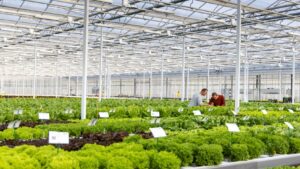For Eric Christianson, crop specialist and crop coordinator for Rijk Zwaan based in Salinas, Calif., seed runs in the blood.
His family has been involved in the seed industry since his great-grandfather immigrated to the United States from Sweden.
“I often remember picking vegetables from the garden, cultivating my interest in natural sciences and my dad bringing seed clients over for dinner from all over the world,” he says. “From the day I first started working, I’ve been working in seed. I got my work ethic from my dad.”
After high school, Christianson studied crop science and agribusiness at Washington State University, which was where he caught the bug for research — literally. He continued his education with a master’s degree in plant pathology with a portion of his studies focusing on plant genetics and breeding, and also entomology.
“I remember one of my entomology teachers approaching me and saying, ‘Hey, we have this undergraduate research position open, and I think you’d be a good fit. I think the idea for me was to eventually build a skill set to go into more of a commercial position, to be a more technical, commercially-oriented person.”
After completing his studies, he began working with Rijk Zwaan in Salinas.
Even though his job focuses on spinach, which he finds to be a stimulating and challenging crop to work in both logistically and genetically, Christianson really loves working with radishes.
Red radish is a quick turnaround crop, he notes, maturing between 21 and 60 days. Because of this sand the incredibly specific genetics-by-environment interaction, there are some challenges with finding varieties that work consistently, he says. This challenge, he says, makes it a great, strategic crop to work in.
“For someone like me with a short attention span, it’s so fun to work with. There’s a lot of environmental factors that go into how varieties perform, how certain genetics perform, and you really have to pick carefully the genetics you push forward because you can find a radish that performs well in a small micro environment, but if you take it to the next farm down the road, it won’t perform the same. Trying to find that diamond in the rough is fun.”
It’s also a vegetable that’s consumed worldwide, which adds a whole different dimension to radish breeding, he adds.
“Most people in North America know red radish, but you go to Asia, for example, and they love white radish. That diversity keeps things interesting.”
In the future, Christianson is excited to see what new, advanced breeding technologies can bring to the table as solutions and challenges for the seed industry.
“We have new varieties in every segment that I work with. In radish, we’re focusing on European type radishes which typically are smaller and breeding them for an American market. The American radish is typically bigger, as they need to stand up to stand up to a more extreme environment,” he says.
In spinach, he’s currently working on disease resistance issues and boosting yield.
“There’s some exciting stuff coming down the pipe.”
—with files from Alex Martin











